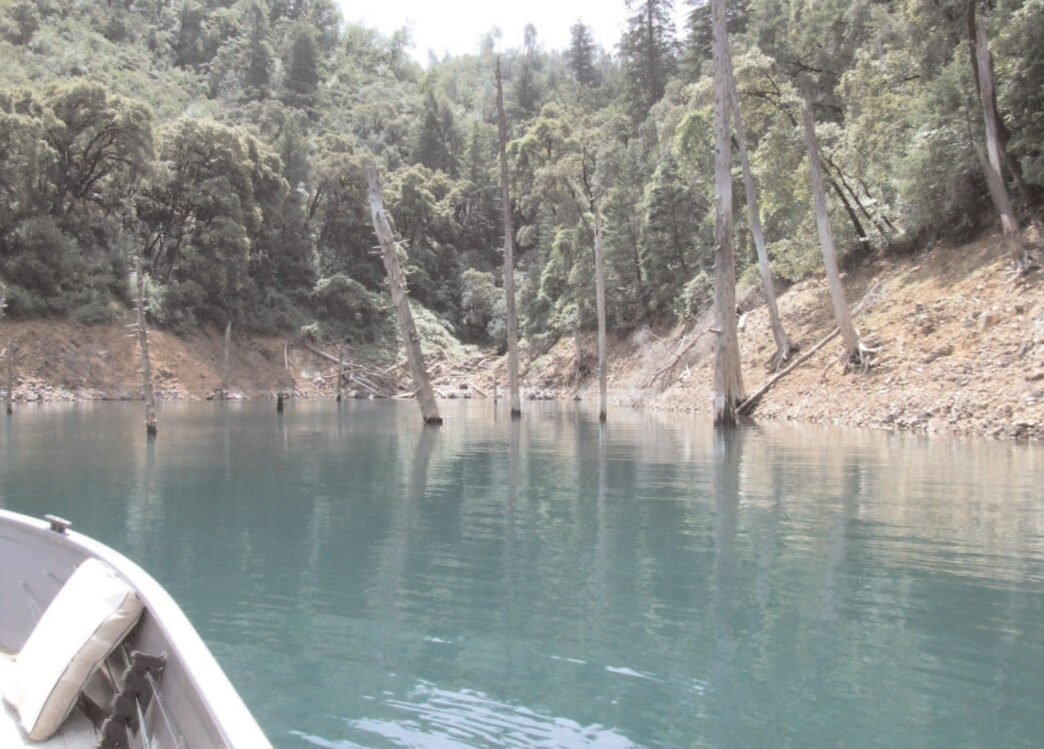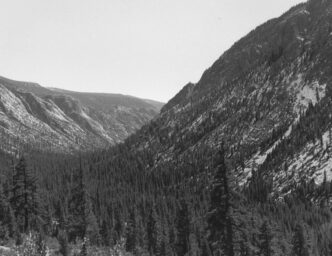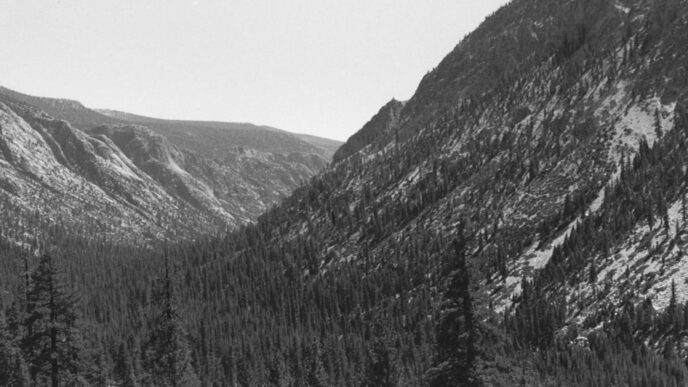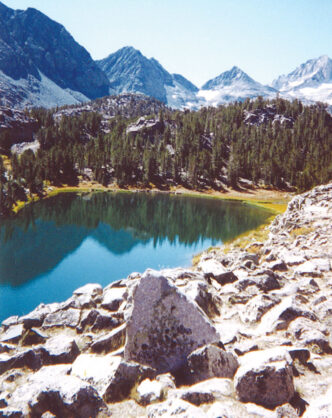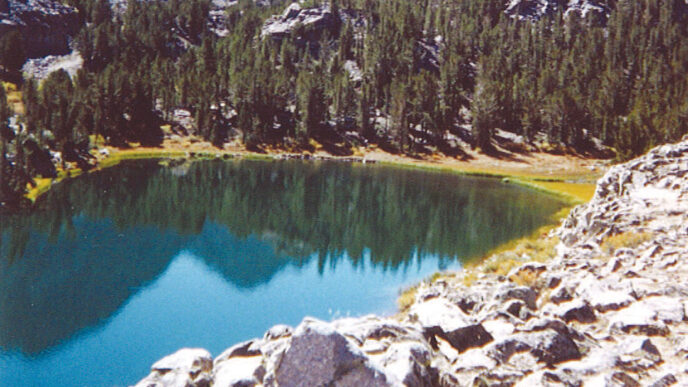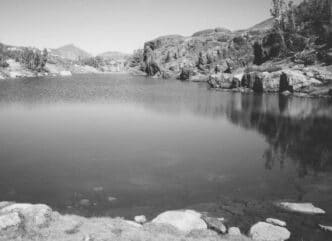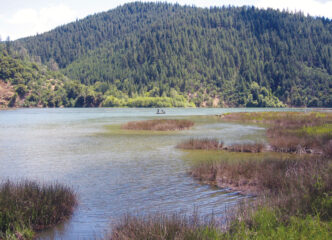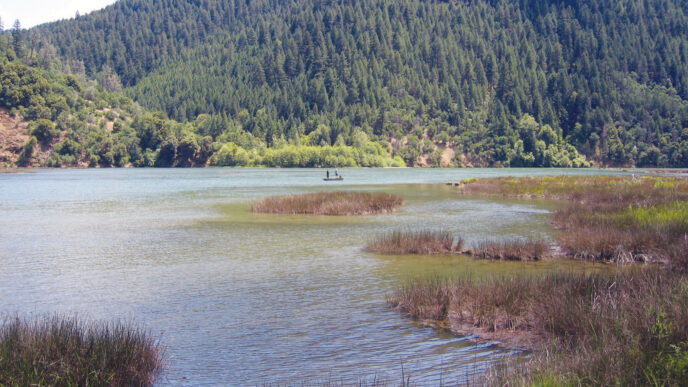Certain things are seemingly too enormous to wrap your mind around, which may be what keeps more fly anglers from exploring the exciting fishing on Shasta Lake. Declaring that you plan to fish it is like saying you’re going on vacation to, say, the Southern Hemisphere, the Atlantic Ocean, or outer space. Fine — but where exactly in all those expanses do you intend to go?
Shasta Lake is big water, and the idea of conquering its 370 miles of shoreline with fly gear causes even experienced anglers to teeter on the edge of performance anxiety. Shasta Lake is the middle member of the so-called “ Three Shastas,” Mount Shasta, Shasta Lake, and Shasta Dam, and like the other two, it is massive and daunting.
One easy way to break down this gargantuan place is according to fish species. Think of Shasta as a collection of distinctly different fisheries grouped together under the common name “Shasta.” While there may be a certain overlap between the trout and bass fisheries, success in each specific venue depends on species-specific strategies and tactics. Most days, you catch what you intend to catch.
Shasta contains rainbow trout, brown trout, largemouth bass, smallmouth bass, and Alabama spotted bass (Micropterus punctulatus). There are, of course, plenty of other species, such as salmon, panfish of all sorts, carp, catfish, bullheads, and sturgeon, but these are not typically pursued with a fly rod. For the fly angler, it’s generally about trout and bass, and with good reason. But first, you need a plan.
Decisions, Decisions . . .
Which is more important, what you are fishing for, or when you want to fish? Shasta trout are most often in the upper water column (the top 20 feet) during the cooler months of the winter and spring. As the lake’s surface warms during the summer and fall, the bass, especially the largemouths, occupy the upper water column, and the trout go deep. Smallmouths and Alabama spotted bass prefer water temperatures somewhere in between the two — warmer than what trout like, cooler than what largemouth bass prefer — so they are best targeted during the early and late months of the spring and fall.
Once the “what” and “when” decisions are made, it’s time to think about the “where” aspect of your plan, and this poses the question of access to a boat. There are places where you can fish from shore and times when you can do all right as a shorebound angler, or even when a float tube or pontoon boat would not be out of the question, but these are only places to which you can easily drive. Trying to fish Shasta without a boat is like trying to walk across the Internet. However, on Shasta, you can do just fine with the equivalent of dial-up. Although you sometimes see those big, garish, glittery bass boats with every convenience, from sonar to portable satellite dishes, you can easily get by with a much less sophisticated setup. In all but the most inclement weather, a small rowboat or pram equipped with a suitable gas motor will do the job nicely. Shasta has 13 public boat-launch ramps, so it becomes a matter of choosing the one closest to the area you want to explore. If you Google “Shasta Lake Map,” you will quickly see that resources abound to help you find your way around.
The Rainbow Trout Fishery
When you recall that three of Shasta’s four tributaries are famous wild rainbow trout fisheries, it isn’t hard to imagine how there might be some opportunities to catch rainbows in the lake itself. But the nature of fly fishing precludes trolling with downriggers in the main body of the lake, a popular and often effective method for conventional-gear anglers. Since we are limited to the top 20 feet or so of the water column, it’s important to consider when rainbows are most likely to be in that zone. Shasta holds both wild and hatchery rainbows, but I frankly would not go to Shasta to target hatchery fish. The lower reaches of the upper Sacramento, Pit, and McCloud Rivers offer terrific opportunities for wild rainbows in water that is technically still called “Shasta Lake.”
You can reach the upper McCloud arm of Shasta by exiting northbound Interstate 5 at the Gilman Road exit and driving east. The bridge over the lake or river (depending on the water level) is 17 miles east of the freeway. In zones like this, which are sometimes lake and sometimes river, rainbows migrate between the still water of the lake and the running water of the rivers. During periods of high water, when you can take a boat above the McCloud bridge, note that there is private property on both sides, and stepping out of your boat is trespassing. The land below the bridge is public, however, so feel free.
I especially like to fish this area in the late fall, when, due to low lake levels, the running McCloud River water may extend several miles downstream of the bridge. Technically, the McCloud River is closed to angling between November 15 and the last Saturday in April. Below the bridge, however, this running water is considered to be part of Shasta Lake and is open to angling all year long.
The Pit River below Powerhouse 7 and the upper Sacramento are open to fishing all year, but note that fish also migrate between still and running water, so the lower reaches may well prove productive, especially in the spring, when wild rainbows migrate up these streams to spawn. To explore running water in the Sacramento arm, either hike downstream from the Dog Creek access or up from Lakehead.
The boundary between the Pit River and the lake is a small dam off of Fenders Ferry Road. To get to this area, drive east from Redding on Highway 299. Just past Round Mountain, turn left on Fenders Ferry Road and continue until it crosses the water. It’s not unusual to discover caddisflies popping on this water on warm days as early as February. Big rainbows don’t let this abundant feed go unnoticed.
With a lake as large as Shasta, it seems silly to think of flies as small as midges, but in the wintertime, rainbows will move into the shallower areas looking for these very things. Try wading into shallow flats and just hanging a small midge pupa pattern under a small floating strike indicator. I’ve been astounded at some of the quality fish I’ve caught this way on Shasta. Most of the public boat launch-ramp areas are situated near shallow flats and are excellent places to start. A typical trout rod, say a 9-foot 5-weight, works very well on Shasta.
The Brown Trout Fishery
This is an easy one. Since the Cantara Loop spill in the 1990s on the upper Sacramento, that stream is virtually devoid of brown trout. (Fortunately, the rainbow trout have returned to the upper Sac like gangbusters.) And on Shasta’s Pit arm, browns cannot swim up the Pit River, due to the dam that separates the two. That leaves the McCloud arm of Shasta as the lake’s brown trout fishery, and it’s a dandy. But knowing when to fish for these browns is anything but intuitive.
If this were a “normal” situation, you might expect Shasta browns to run up the McCloud River to spawn in the fall. They do spawn in the fall, but that’s not when they move from the lake to the river. There are two distinct groups of brown trout in the McCloud River. One group stays in the river year round and never moves down to the lake. The other group moves down to the lake in the fall and winter after spawning to feed on the abundant threadfin shad for several months. These browns migrate back up the McCloud arm in March and April.
The typically higher water of the spring makes brown trout fishing from a boat or pontoon boat on the McCloud arm of Shasta a great idea. Full sinking lines and Clouser minnows, Zonkers, or Woolly Buggers can elicit predatory responses from these browns, and some of these fish are really huge. They are the fish that sit in the bottom of the McCloud’s deep pools all summer long and feed almost exclusively after dark. They will spawn in the fall before migrating down to Shasta all over again.
I fish the same equipment for Shasta browns as I do for Shasta bass. I like a 91/2-foot rod for a 6-weight line. It’s long enough and stiff enough to toss streamers or bass bugs a goodly distance, yet not so stiff that it feels like you’re fishing with a broomstick. Anything similar to this setup will probably work just fine.
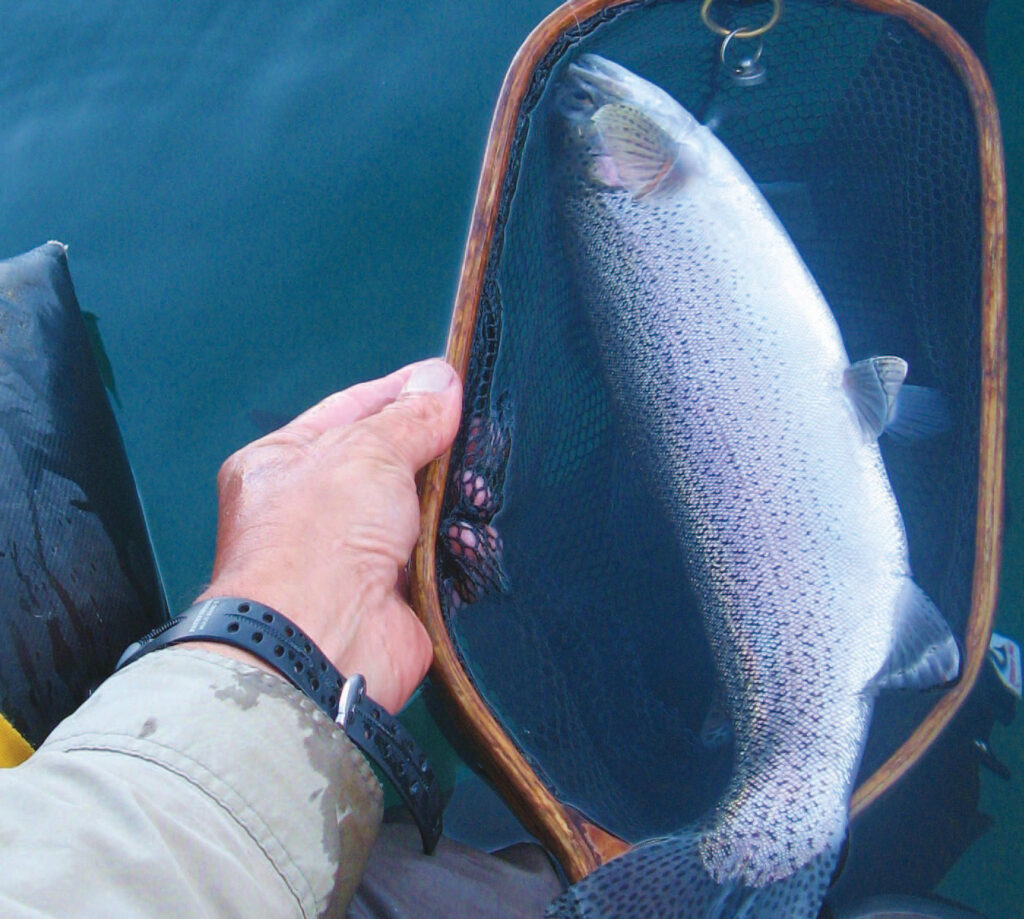
The Largemouth Bass Fishery
Of the bass species found in Shasta, the largemouth population favors the warmest water, and you can use this information to your advantage. They also really like to hang close to structure, such as submerged trees and bushes — anything that provides a hiding place from which to ambush food. Since the Pit arm of Shasta is the only area of the lake that didn’t get logged before the boys shipped overseas for World War II, this is where I like to prospect for Shasta bucketmouths. The urge to spawn draws these fish to shallow water, which means March, April, and May are the prime months for this fishing. When targeting largemouth bass, I prefer to fish with poppers on the surface. It’s kind of an addiction. It seems to me that if you have to go subsurface, you might as well fish for Shasta smallies or Alabama spotted bass. Both of these species are much more likely to school up, meaning that when you find one fish, there are probably others close by. Not so with largemouths. They are brooding, predatory, foul-tempered, solitary feeders who seem to live for splashy, violent grabs. There’s nothing like getting on the water before dawn on a warm spring morning, heading up the Pit arm, and tossing bass poppers at shoreline bushes or the remains of ancient trees.
Shasta largemouths feed on threadfin shad, panfish, crayfish, and almost any hapless creature that falls into the water. Flies that imitate any of the aforementioned will work. What’s important is that you get your fly into places where it might be properly ambushed, meaning close to cover.
The Smallmouth Bass and Alabama Spotted Bass Fisheries
I’ve always lumped these two species together, since they’re very similar in their preferred habitat and feeding behavior. It always surprises me how many people can’t tell these different fish apart. Here’s a quick lesson.
First, if the corner of the fish’s mouth extends beyond the back of the eye socket, it’s neither one of these — it’s a largemouth bass. The mouths of both smallmouths and Alabama spotted bass end just below their eyes. Smallmouths have greenish, whiskerlike markings on their gill covers and very faint lateral lines, if any. They often appear slightly green or even yellowish in color. Alabama spotted bass have distinctly pronounced dark lateral lines and variegated markings on their upper backs. Look for these bass around rocky points, drop-offs, and cruising back and forth along submerged rock walls. While smallies and Alabama spotted bass will hit surface flies, they are less likely to do so than largemouth bass. Threadfin shad patterns, crayfish patterns, or any general attractor pattern that wiggles, shakes, or shimmies underwater will work. Since the water they prefer is cooler than the water preferred by largemouth bass, you usually need to fish deeper for them. Type IV or V full sinking lines will get your streamers down into the right zone.
Shasta has of plenty rocky areas, which is part of the reason why these bass do so well. Look for rocky walls dropping off into the depths. Position your boat 25 to 30 feet away and launch your streamer at the base of the rock face. Wait . . . wait . . . wait a little longer (you’re letting your fly sink), then start a strip-strip-pause retrieve. Vary your speed until you discover the cadence that the fish prefer that day.
Bait Balls
During the winter and spring, huge schools of threadfin shad move about Shasta Lake en masse, occasionally breaking the surface and grabbing the attention of every fish and bird in the vicinity. It’s a carnival atmosphere all right, but this spectacle also presents an intriguing conundrum for anglers.
Picture a massive raft of glittering jewels wiggling, writhing, and undulating into and out of itself. Schools breach the surface, glistening and moving like some great living thing, then slowly sink back out of sight. I once found myself in the middle of one of these in my float tube, which was definitely an odd sensation. It was a warm, sunny December day, and I had positioned my tube fairly close to Shasta Dam, but off to one side.
While the bait ball is quite impressive to watch, I’ll tell you what doesn’t work in fishing this phenomenon. It’s a waste of time to try to match this “hatch” by throwing a Clouser or other imitative baitfish pattern into the fray. Why would a fish grab your fly when there are tens of thousands of naturals so close by? This is actually a good time to throw something different, for a change.
Flies as pedestrian as a size 10 black Beadhead Woolly Bugger are all you need for this fishing. Your choice of pattern doesn’t have to be anything special, but you do not want it to look like everything around it. You want a pattern that looks alive, isn’t too big, and will sink beneath the mass of baitfish. This is where both the bass and the trout are waiting, and the fishing can be hot. Fly fishing Shasta requires a plan, the right equipment, and the ability to break this colossal piece of water down into smaller pieces. It’s a tremendously beautiful place, and because of its size you can often have vast areas completely to yourself as you enjoy the great fishing while bald eagles ride the thermals overhead.




